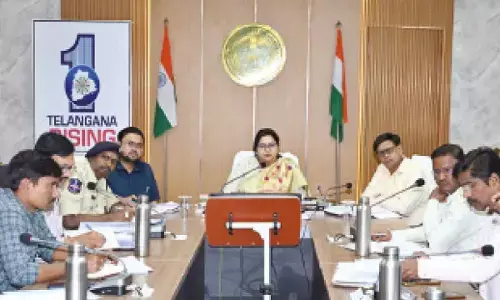Dissecting India’s employment scenario brings forth startling revelations

There is a need to accelerate the pace of capacity building
Employment is an important issue. Every government tries its best to create gainful opportunities for its workforce through a slew of policy measures. As the Indian economy is expanding, more and more jobs are being created. There is, however, a difference of opinion over the pace and number of enabling economic opportunities being created across the country.
India Employment Report 2024: Youth Employment, Education and Skills, recently released by the International Labour Organization (ILO) and the Institute for Human Development (IHD), is quite bullish about our country’s prospects. It talks of our demographic dividend with our youth population being pegged at 27 per cent of the total population in 2021.
The executive summary of the report gives us an insight into the broader picture.
It is, in fact, full of points worth pondering over for all stakeholders irrespective of their biases, prejudices and preferences. Though Indian intellectuals, enlightened elites, academic scholars and so-called role models from different fields love to speak as per their convenience since they wish to be politically correct, the ideal situation in a country as diverse as ours would be in mustering the courage to call a spade a spade. This should have applied to our economic, political, social, financial and cultural landscapes so that we come out with better inferences for inclusive outcomes.
The report rightly observes that “highly educated youths tend to more actively engage in the high-productivity sectors, primarily the tertiary sector, such as business, telecom, finance, and information technology. Skills and knowledge acquired through higher education equip these individuals with the expertise required to excel in these sectors, which contributes significantly to economic growth and development. Less-educated youth are more likely to be employed in the primary (agriculture) and secondary sectors (manufacturing and construction). Youth with technical degrees and graduate diplomas are involved more in the tertiary sector. The probability of any kind of employment is lower as education rises but higher for youth having technical education.”
Do we have enough infrastructures to impart quality technical education to our youth? Perhaps, we do not have. Therefore, there is a need to accelerate the pace of capacity building across the spectrum of higher education in the country. The report also says that “even among the technically qualified youths, nearly two fifths of them engaged in vocations that did not correspond to their qualifications...Despite the considerable progress, the level of educational attainments at higher levels remains low and quality is a concern. The drop-out rates after the middle and secondary levels of education in poorer states and among marginalized groups are high. Enrolment in higher education, although on the rise, is much lower than the levels in developed as well as in middle-income countries. The quality of education continues to remain a concern. There is a significant learning deficit at the school level and the quality of education imparted by institutions of higher learning remains poor.” Talking about skills, the report rightly says that “India’s skills scenario has changed significantly over the past 25 years or so. A national skills mission has been set up, and two national skills policies have been formulated to guide skills development. A Ministry of Skill Development and Entrepreneurship was established in 2014, with several institutions created to work in partnership with the private sector to determine skills gaps, create courses, implement programmes and certify skills.”
The report points to “limited uptake of training due to factors on both the supply and demand sides, even though there is evidence of a gap between the supply and demand for skills. Second, there are spatial imbalances in the training. The creation of training capacity is low in poorer regions where the potential demographic advantage is high. Third, there are low levels of socio-economic inclusion in training programmes, despite evidence that training positively relates to education and socio-economic levels. Fourth, the overarching
nature of informality makes it difficult to design training such that returns from it can be internalized by trainees.
And fifth, the returns from training are inadequately remunerated in the labour market, making training socially and economically less attractive.”
Talking about apprenticeship, the report claims that “although there is a renewed focus on apprenticeship training, low apprenticeship enrolment against the stated targets is an issue of concern. Of around 120,000 establishments, only around 25,000 offer apprenticeships. Given the size of the youth population, it is very low. Fresh stimulus for entrepreneurship development is an important policy instrument. Although government policy stressed entrepreneurship development in the past, it only recently was singled out as a key instrument to create a fresh supply of and demand for jobs.
The National Policy for Skill and Entrepreneurship Development articulates five pillars of an ideal environment for entrepreneurship: access to funding; an entrepreneurial culture; supportive regulatory and tax regimes; educational systems that support entrepreneurial mindsets; and a coordinated approach that links the public, private and voluntary sectors. But there has hardly been satisfactory progress in most of these spheres.”
Still, we need not be disappointed. Gaps in policy measures offer a historic opportunity to align them with ground realities and make the journey to empower more inclusive. Since our country will celebrate 100 years of Independence in 2047, all stakeholders should come together to reform and transform our higher education, which is still out of the reach of the vast masses of the country. If less than 4.50 crore youth are enrolled in higher education institutions even after 75 years of freedom, then we certainly need to worry about our future prospects. Notwithstanding Article 21A of the Constitution mandating that “the State shall provide free and compulsory education to all children of the age of six to fourteen years in such manner as the State may, by law, determine” there is a pressing need to reflect and take corrective measures.
Deprivation must not be allowed to become a tool of governance in any respect for peace, happiness and prosperity of the future generations.




















